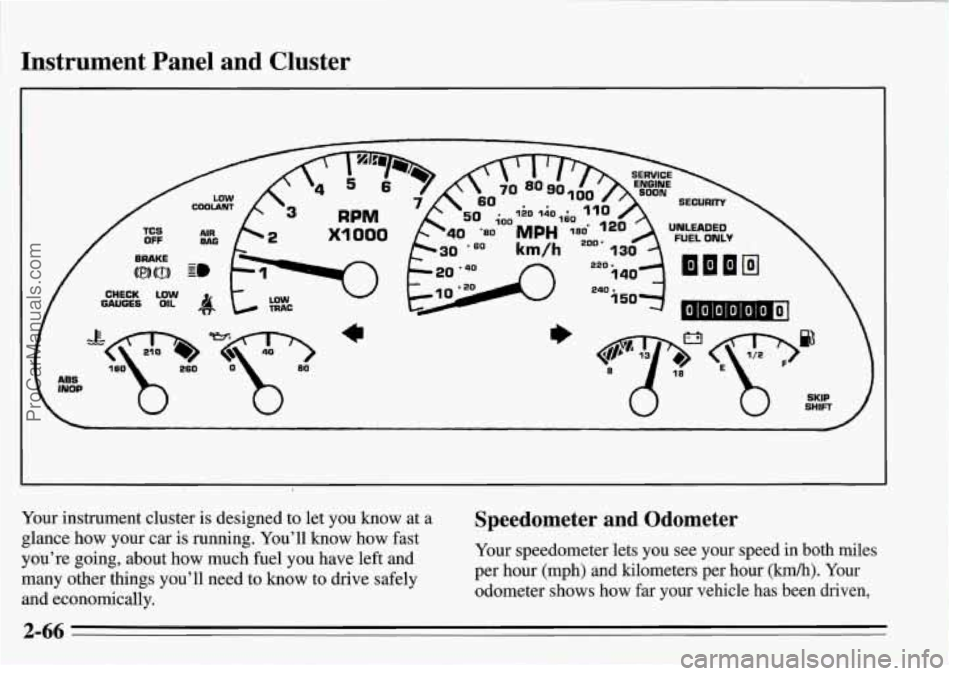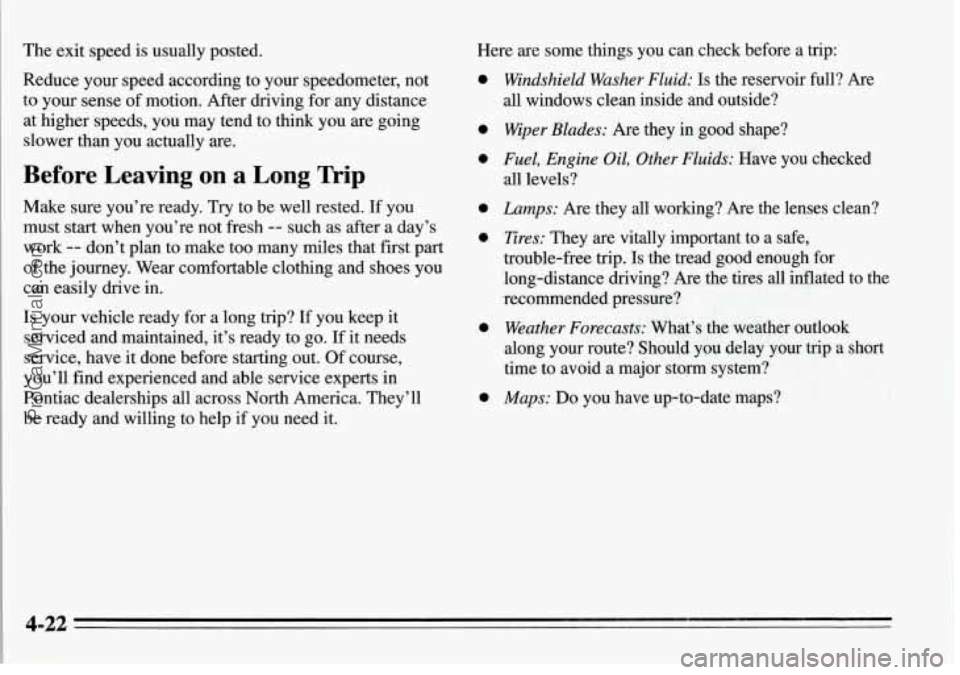check oil PONTIAC FIREBIRD 1995 Owners Manual
[x] Cancel search | Manufacturer: PONTIAC, Model Year: 1995, Model line: FIREBIRD, Model: PONTIAC FIREBIRD 1995Pages: 386, PDF Size: 19.66 MB
Page 113 of 386

Instrument Panel and Cluster
CHECK LOW GAUGES OIL
Your instrument cluster is designed to let you know at a Speedometer and Odometer
glance how your car is running. You’ll know how fast
you’re going, about how much fuel you have left and
many other things you’ll need to know to drive safely
and economically. Your speedometer lets you see your speed in both miles
per hour (mph) and lulometers per hour
(km/h). Your
odometer shows how far your vehicle has been driven,
2-66
ProCarManuals.com
Page 124 of 386

Low Oil Light
LOW
OIL
I NOTICE.:
The oil level monitoring system only checks the
oil level when you are starting your engine.
It
does not keep monitoring the level once your
engine is running. Also, the oil level check only
works when the engine has been turned
off long
enough for the oil to drain back into the oil pan.
Your vehicle is equipped with an oil level monitoring
system. When you start your engine, the red warning
light
will come on briefly. If the light doesn’t come on,
have it repaired.
If the light stays on after starting your
engine, your engine oil level may be too low. You may
need to add oil. See “Engine Oil” in the Index.
2-77
ProCarManuals.com
Page 149 of 386

_-
Care of Your Compact Discs
Handle discs-cafefully. Store them in their original cases
or other protective cases and away from direct sunlight
-and dust. If the surface of a disc is soiled, dampen a
clean, soft cloth in a mild, neutral detergent solution and
clean it, wiping ftom the center to the edge.
Be sure never to touch the signal surface when handling
discs. Pick up discs by grasping the outer edges or the
edge
of the hole and the outer edge.
Fixed Mast Antenna
The fixed mast antenna can withstand most car washes
without being damaged.
If the mast should ever become
slightly bent, you can straighten it out by hand. If the
mast is badly bent, as it might be by vandals, you should
replace it.
Check every once in a while to be sure the mast is still
tightened to the fender.
3-16
ProCarManuals.com
Page 173 of 386

The exit speed is usually posted.
Reduce your speed according to your speedometer, not
to your sense of motion. After driving for any distance
at higher speeds, you may tend to
think you are going
slower than you actually are.
Before Leaving on a Long Trip
Make sure you’re ready. Try to be well rested. If you
must
start when you’re not fresh -- such as after a day’s
work
-- don’t plan to make too many miles that First part
of the journey. Wear comfortable clothing and shoes you
can easily drive in.
Is your vehicle ready for a long trip? If you keep it
serviced and maintained, it’s ready to go.
If it needs
service, have it done before starting out. Of course,
you’ll find experienced and able service experts in
Pontiac dealerships all across North America. They’ll
be ready and willing to help if you need it.
Here are some things you can check before a trip:
a
e
a
a
a
e
e
Windshield Washer Fluid: Is the reservoir full? Are
all windows clean inside and outside?
Wiper Blades: Are they in good shape?
Fuel, Engine Oil, Other Fluids: Have you checked
all levels?
Lamps: Are they all working? Are the lenses clean?
Tires: They are vitally important to a safe,
trouble-free trip. Is the tread good enough for
long-distance driving? Are the tires all inflated to the
recommended pressure?
Weather Forecasts: What’s the weather outlook
along your route? Should you delay your trip a short
time to avoid a major storm system?
Maps: Do you have up-to-date maps?
4-22
ProCarManuals.com
Page 189 of 386

Parking on Hills
You really should not park your vehicle, with a trailer
attached, on a
hill. If something goes wrong, your rig
could
start to move. People can be injured, and both
your vehicle and the trailer can be damaged.
But if you ever have to park your rig on a hill, here’s
how to
do it:
1. Apply your regular brakes, but don’t shift into
PARK (P) yet, or into gear for a manual transmission.
2. Have someone place chocks under the trailer wheels.
3. When the wheel chocks are in place, release the
regular brakes until the chocks absorb the load.
4. Reapply the regular brakes, Then apply your parking
brake, and then shift to PARK (P), or REVERSE (R)
for a manual transmission.
5. Release the regular brakes.
When You Are Ready to Leave After
Parking on a Hill
1. Apply your regular brakes and hold the pedal down
while you:
Start your engine;
0 Shift into a gear; and
0 Release the parking brake.
2. Let up on the brake pedal.
3. Drive slowly until the trailer is clear of the chocks.
4. Stop and have someone pick up and store the chocks.
Maintenance When Trailer Towing
Your vehicle will need service more often when you’re
pulling a trailer. See the Maintenance Schedule for more on this. Things that
are especially important in trailer
operation
are automatic transmission fluid (don’t
overfill), engine oil, axle lubricant, belts, cooling
system, and brake adjustment. Each
of these is covered
in this manual, and the Index will help you find them
quickly.
If you’re trailering, it’s a good idea to review
these sections before you start your trip.
Check periodically to see that all hitch nuts and bolts are
tight.
4-38
ProCarManuals.com
Page 238 of 386

Gasolines for Cleaner Air
Your use of gasoline with deposit control additives will
help prevent deposits from forming in your engine and
fuel system. That helps keep your engine in tune and
your emission control system working properly. It’s
good for your vehicle, and you’ll be doing your part for
cleaner air.
Many gasolines are now blended with oxygenates. General Motors recommends that you use gasolines with
these blending materials, such as MTBE and ethanol. By doing
so, you can help clean the air, especially in those
parts of the country that have high carbon monoxide
levels.
In addition, some gasoline suppliers are now producing
reformulated gasolines. These gasolines
are specially
designed to reduce vehicle emissions. General Motors
recommends that you use reformulated gasoline. By doing
so, you can help clean the air, especially in those
parts
of the country that have high ozone levels.
You should ask your service station operators if their
gasolines contain deposit control additives and
oxygenates, and if they have been reformulated to
reduce vehicle emissions.
Fuels in Foreign Countries
If you plan on driving in another country outside the
U.S. or Canada, unleaded fuel may be hard to find. Do
not use leaded gasoline. If you use even one tankful,
your emission controls won’t work
well or at all. With
continuous use, spark plugs can get fouled, the exhaust
system can corrode, and your engine oil can deteriorate
quickly. Your vehicle’s oxygen sensor will be damaged.
All of that means costly repairs that wouldn’t be covered
by your warranty.
To check on fuel availability, ask an auto club, or
contact a major oil company that does business in the
country where you’ll be driving.
You can also write us at the following address for
advice. Just tell us where you’re going and give your
Vehicle Identification Number
(VIN).
General Motors Overseas Distribution Corporation
North American Export Sales
(NAES)
1908 Colonel Sam Drive
Oshawa, Ontario LlH
8P7
6-5
ProCarManuals.com
Page 245 of 386

Before closing the hood, be sure all the filler caps are
on.
Then just pull the hood down and close it firmly.
Engine Oil
LOW
OIL
If the LOW OIL light on the instrument panel comes on,
it means you need to check your engine oil level right away. For more information, see
LOW OIL in the Index.
You should check your engine oil level regularly; this is
an added reminder.
It’s a good idea to check your engine oil every time you
get fuel.
In order to get an accurate reading, the oil must
be warm and the vehicle must be on level ground.
ProCarManuals.com
Page 247 of 386

5.7L LT1 (Code P) Oil Dipstick Location 3.4L L32 (Code S) or 3.SL L36 (Code K)
Turn off the engine and give the oil a few minutes to
drain
back into the oil pan. If you don’t, the oil dipstick
might not show the actual level.
To Check Engine Oil
Pull out the dipstick and clean it with a paper towel or
cloth, then push it back in all the way. Remove it again,
keeping the
tip down, and check the level.
5.7L LTl (Code P)
ProCarManuals.com
Page 255 of 386

4. Open the air cleaner and remove the filter.
Automatic Transmission Fluid
When to Check and Change
A good time to check your automatic transmission fluid
level is when the engine oil is changed. Refer to the
Maintenance Schedule to determine when to change
your fluid. See “Scheduled Maintenance Services” in the
Index.
How to Check
Because this operation can be a little difficult, you may
choose to have this done at your Pontiac dealer Service
Department.
If you do it yourself, be sure to- follow all the
instructions here, or you could get a false reading on the dipstick.
NOTICE:
Too much or too little fluid can damage your
transmission.
Too much can mean that some of
the fluid could come out and fall on hot engine
parts or exhaust system parts, starting a fire. Be sure to get an accurate reading if you check your
transmission fluid.
.
6-22
ProCarManuals.com
Page 306 of 386

Capacities (Approximate)
The following approximate capacities are given in U.S.
and metric conversions.
Air Conditioning? See the refrigerant information label
under the hood.
Automatic Transmission
Drain and Refill .................. 10 pt. (4.7 L)*
VIN Engine Code S and K ....... 17.6 pt. (8.3 L)*
VIN Engine Code P ............ 21.6 pt. (10.2 L)*
VIN
Engine Code S
Overhaul
Cooling System
With Manual Transmission . . , . . 12.5 qt. (11.8 L)
With Automatic Transmission ... 12.3 qt. (11.6 L)
VIN Engine Code K
With Manual Transmission ..... 12.5 qt. (1 1.8 L)
With Automatic Transmission ... 12.3 qt. (11.6 L)
With Manual Transmission ..... 15.3 qt. (14.5 L)
With Automatic Transmission ... 15.1 qt. (14.3 L)
VIN Engine Code P
Crankcase
Without Filter Change ........... 4.0 qt. 1 (3.8 L)**
With Filter Change ............. 5.0 qt. (4.7 L)**
Fuel Tank ...................... 15,5 gal. (58.7 L)
Manual Transmission
Five-Speed
.................... 5.9 pt. (2.8 L)*
Six-Speed ..................... 8.0 pt. (3.8 L)*
Rear Axle Lubricant ................. 3.5 pt. (1.7L)
? Not all air conditioning refrigerants are the same. If the
air conditioning system in your vehicle needs refrigerant,
be sure the proper refrigerant is used.
If you’re not sure,
ask your Pontiac dealer.
* Recheck fluid level after filling. See “Automatic
Transmission Fluid” or “Manual Transmission Fluid”
in the Index.
** Recheck the oil level after filling. See “Engine Oil” in
the Index.
6-73
ProCarManuals.com